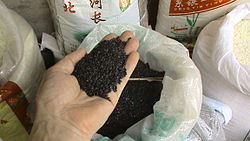Black rice


Black rice is a range of rice types of the species Oryza sativa L., some of which are glutinous rice. Black rice is also known as ‘Forbidden Rice’ in Ancient China since only those belonging to the upper class could afford to eat it.[1]
There are several varieties of black rice available today, these include Indonesian black rice, Philippine balatinaw rice,[2] and Thai jasmine black rice. Black rice is known as chak-hao in Manipur, where desserts made from black rice are served at major feasts.
In Bangladesh it is known as kalo dhaner chaal (black paddy rice) and used to make polao or rice-based desserts. The bran hull (outermost layer) of black rice contains one of the highest levels of anthocyanins found in food.[3] The grain has a similar amount of fiber to brown rice and, like brown rice, has a mild, nutty taste.[4]
Black rice has a deep black color and usually turns deep purple when cooked. Its dark purple color is primarily due to its anthocyanin content,[5] which is higher by weight than that of other colored grains.[6][7] It is suitable for creating porridge, dessert, traditional Chinese black rice cake, bread, and noodles.
| Name | Amount | Unit |
|---|---|---|
| Energy | 356 | kcl |
| Protein | 8.89 | g |
| Total lipid (fat) | 3.33 | g |
| Carbohydrate, by difference | 75.56 | g |
| Fiber, total dietary | 2.2 | g |
| Sugars, total including NLEA | 0 | g |
| Calcium, Ca | 0 | mg |
| Iron, Fe | 2.4 | mg |
| Sodium, Na | 0 | mg |
| Vitamin C, total ascorbic acid | 0 | mg |
| Vitamin A, IU | 0 | IU |
| Fatty acids, total saturated | 0 | g |
| Fatty acids, total trans | 0 | g |
| Cholesterol | 0 | mg |
See also
References
- ^ Saikia, Partha. "Black Rice-Nutrition, Recipe & Benefits (Manipuri Black Rice)". North East India info. Retrieved 2020-06-25.
{{cite web}}: CS1 maint: url-status (link) - ^ "Heirloom rice preserved, made productive". Philippine Rice Research Institute. Department of Agriculture, Philippines. 2017-02-20. Retrieved 29 June 2018.
- ^ Yao, S. L.; Xu, Y; Zhang, Y. Y.; Lu, Y. H. (2013). "Black rice and anthocyanins induce inhibition of cholesterol absorption in vitro". Food & Function. 4 (11): 1602–8. doi:10.1039/c3fo60196j. PMID 24056583.
- ^ "Food Grains of India". Bulletin of Miscellaneous Information (Royal Botanic Gardens, Kew). 232-234. 1892 (70): 234. 1892. JSTOR 4102547.
- ^ Oikawa, T.; Maeda, H.; Oguchi, T.; Yamaguchi, T.; Tanabe, N.; Ebana, K. Yano; M., Ebitani; T., Izawa, T. (2015). "The birth of a black rice gene and its local spread by introgression". Plant Cell. 27 (9): 2401–2414. doi:10.1105/tpc.15.00310. PMC 4815089. PMID 26362607.
{{cite journal}}: CS1 maint: multiple names: authors list (link) - ^ Ichikawa, Haruyo; Ichiyanagi, Takashi; Xu, Bing; Yoshii, Yoichi; Nakajima, Masaharu; Konishi, Tetsuya (2001). "Antioxidant activity of anthocyanin extract from purple black rice". Journal of Medicinal Food. 4 (4): 211–218. doi:10.1089/10966200152744481. PMID 12639403.
- ^ Abdel-Aal, El-Sayed M; Young, J. Christopher; Rabalski, Iwona (2006). "Anthocyanin composition in black, blue, pink, purple, and red cereal grains". Journal of Agricultural and Food Chemistry. 54 (13): 4696–704. doi:10.1021/jf0606609. PMID 16787017.
- ^ "FoodData Central". fdc.nal.usda.gov. Retrieved 2020-06-25.
- ^ Saikia, Partha. "Black Rice-Nutrition, Recipe & Benefits (Manipuri Black Rice)". North East India Info. Retrieved 2020-06-25.
{{cite web}}: CS1 maint: url-status (link)

